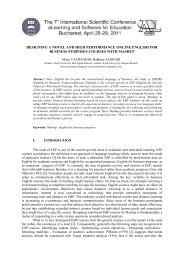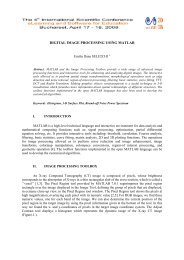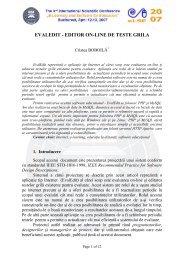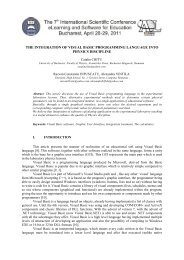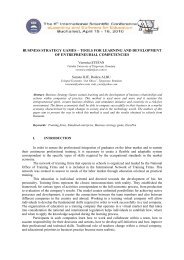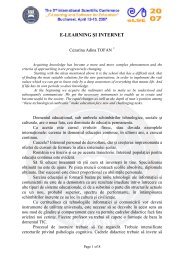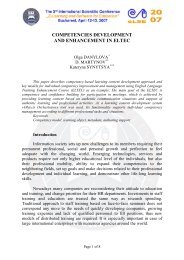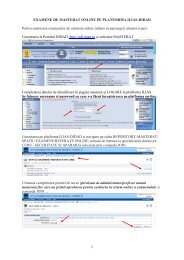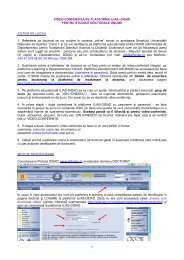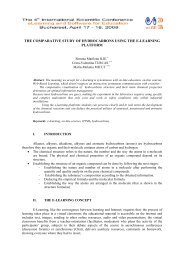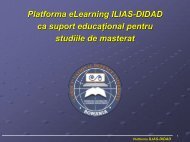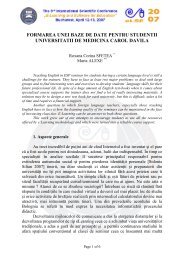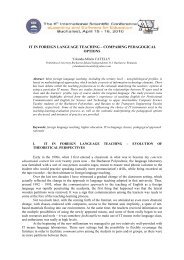top down approach to apply lms (egypt case study)
top down approach to apply lms (egypt case study)
top down approach to apply lms (egypt case study)
Create successful ePaper yourself
Turn your PDF publications into a flip-book with our unique Google optimized e-Paper software.
Around the same time came the rise of hosted learning management systems which is define<br />
as a cloud programming methodology (in the early part of the decade). Hosted platforms found some<br />
success by reducing the complications that are associated with the purchasing and maintenance of<br />
large technical systems. The second attempt at managing eLearning, having drawn from the mistakes<br />
of early eLearning failures, content developers responded with more engaging content — and finally,<br />
eLearning began <strong>to</strong> work.<br />
LMS vendors started <strong>to</strong> offer blended learning initiatives <strong>to</strong> incorporate the new eLearning,<br />
and more attention was paid <strong>to</strong> targeting content <strong>to</strong> learners. Another attempt was made at managing<br />
the relationship of jobs and skills. Consultants, who had learned from early mistakes, recommended a<br />
less granular <strong>approach</strong> <strong>to</strong> competency management. With the availability of Web based self<br />
assessment and peer reviews, competency management came in<strong>to</strong> its own.<br />
1.1 Traditional E-learning: Static Content (SC)<br />
By the end <strong>to</strong> twenty century there are a lot of effort <strong>to</strong> build the e-learning <strong>to</strong>ols in that time<br />
most of that was depending on the static contents like the PDF files or PPT files or any other<br />
electronic type of files used for electronic education. Many sites all over the world convert many<br />
traditional items in the learning life cycle <strong>to</strong> this <strong>to</strong>ols, like get a list of students in Excel sheet or made<br />
a curriculum in the PDF files or at most as a PPT file, but all of this trials was a static <strong>to</strong>ols.<br />
Traditionally, in the world of e-learning content has been anything electronic but not must dynamic.<br />
Developing of the e-learning courses was done by stand-alone desk<strong><strong>to</strong>p</strong> authoring <strong>to</strong>ols the<br />
content of the course was generated in<strong>to</strong> static material of any electronic files like MS files extension.<br />
By this way any modification in the course content required <strong>to</strong> redo the same effort <strong>to</strong> rebuild the<br />
course curriculum that share content, then the situation is aggravated.<br />
For example, consider any school stage that has produced number of online courses. Across<br />
these courses, the image of an electronic part has, say, twenty five occurrences. If the format of this<br />
part is changed, then a new image must replace those twenty five occurrences. As a training manager,<br />
you have <strong>to</strong> ensure that all twenty five occurrences are located (a manual process), and that each,<br />
separately, is updated. This task might also involve processing the original file in many different ways<br />
<strong>to</strong> fit different sizes and screen layouts.<br />
1.2 Applied Software Solutions Categories for Education<br />
There is an important massage say that ' time is consumed in the daily activities needed <strong>to</strong><br />
manage classes, schedules and curricula. By using the teaching <strong>to</strong>ols, teachers can be deferent in many<br />
attitudes like confident, attentive and responsive for students needs and can be able <strong>to</strong> be more<br />
efficient in teaching practices.<br />
The different type of Software can be implemented in the Teaching Frame (This the actual<br />
categories implemented in Egypt).<br />
1. Content Management: There are different categories for the content management started<br />
with any small databank reach <strong>to</strong> the content database like IEEE, EBSCO, PROQUEST … etc this<br />
databases can be either full text database or only bibliographic data for article. When we are going <strong>to</strong><br />
implement this category it started with stand alone implementation for each site then after few years<br />
the implementation methodology got changed <strong>to</strong> implement it through the consortia for many sites<br />
cover around 18 universities (Private and government).<br />
2. Learning Management<br />
• Exams and Quizzes: the software should manage the time schedule, deliver, grade and<br />
evaluate and contact with the student and parents <strong>to</strong> confirm the result online.<br />
• Assignments: the assignment will be interactive and au<strong>to</strong>matically grade them also interact<br />
with the student with the right result.<br />
• Attendance: Moni<strong>to</strong>r attendance; record absence reasons and add explana<strong>to</strong>ry comments<br />
and communicate with the student as will as with the parents.<br />
• Behavior: Record, share and escalate behavioral incidents.<br />
3. Lesson Planning: The lesson will be managing through Software flashes techniques so it<br />
will be <strong>to</strong>tally interactive with the student this mean that the student will have his teacher twenty four<br />
hours a day. This lessons plan that meet national curriculum standards.



